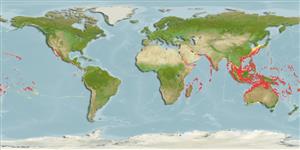Bivalvia |
Pectinida |
Pectinidae
Environment: milieu / climate zone / djupintervall / distribution range
Ekologi
; djupintervall 20 - 183 m (Ref. 93550). Tropical
Indo-Pacific.
Length at first maturity / Size / Weight / Age
Könsmognad: Lm ? range ? - ? cm Max length : 4.5 cm SHL hane/ej könsbestämd; (Ref. 821)
Maximum depth from Ref. 97584. Occurs on soft sediments at intertidal depths (Ref. 87907). Found among coral rubble or attached byssally to hard substrates (Ref. 101147).
Life cycle and mating behavior
Könsmognad | Reproduktion | Lek | Eggs | Fecundity | Larvae
Members of the class Bivalvia are mostly gonochoric, some are protandric hermaphrodites. Life cycle: Embryos develop into free-swimming trocophore larvae, succeeded by the bivalve veliger, resembling a miniature clam.
Raines, B. and M. Huber 2012 Biodiversity quadrupled - Revision of Eatser Island and Salas y Gómez bivalves. Zootaxa 3217:1-106. (Ref. 93550)
IUCN Red List Status
(Ref. 130435: Version 2025-1)
CITES status (Ref. 108899)
Not Evaluated
Not Evaluated
Threat to humans
Harmless
Human uses
| FishSource |
Verktyg
Ytterligare information
Trophic EcologyFood items (preys)
Födosammansättning
Födointag
Predatorer
Population dynamicsTillväxt
Max. ages / sizes
Length-weight rel.
Length-length rel.
Length-frequencies
Mass conversion
Abundans
PhysiologySyreförbrukning
Human RelatedStamps, coins, misc.
Internet-källor
Estimates based on models
Preferred temperature
(Ref.
115969): 18.5 - 28.1, mean 26.1 (based on 758 cells).
Fishing Vulnerability
Low vulnerability (10 of 100).
